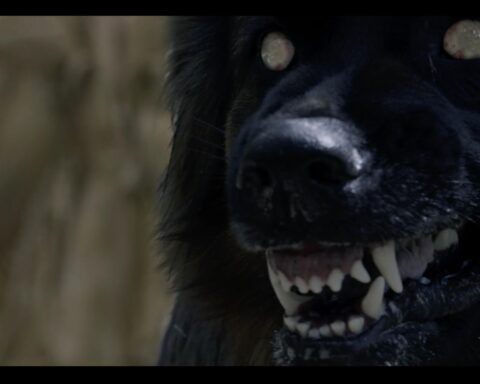Lina Roessler’s Best Sellers emerges as a rare and poignant cinematic triumph, a lamentation and celebration of the human spirit interwoven with the inextricable bonds between creators and their creations. This film, anchored by the towering talents of Michael Caine and Aubrey Plaza, unfolds as a layered narrative—at once a study in human frailty, a critique of the commodification of art, and a delicate exploration of legacy in a world that too often forgets the value of permanence.
Characters as Mirrors of Contradiction
At its core, Best Sellers is an intricate dance between two figures bound by circumstance yet divided by ideology. Michael Caine’s portrayal of Harris Shaw, a cantankerous, misanthropic recluse, is not merely a performance but a lived embodiment of artistic defiance. Shaw, a relic of a literary golden age, is steeped in the ink-stained rigor of a time when words were imbued with weight, where each sentence bore the promise of revelation or destruction. Caine’s interpretation is volcanic—each grumble, each weary gaze, and each biting diatribe against the banalities of modern life echo with the resonance of a man who has both created and been destroyed by his craft.

Yet it is Aubrey Plaza’s Lucy Stanbridge who provides the counterbalance. She is the embodiment of a younger generation navigating a labyrinthine industry increasingly detached from the ideals it purports to celebrate. Plaza, eschewing her trademark sardonic humor, imbues Lucy with a quiet desperation that manifests in measured gestures and moments of profound vulnerability. Lucy’s struggle to reconcile her reverence for literary artistry with the relentless demands of an ever-hungry market mirrors the dilemmas faced by those who strive to preserve integrity in an age of virality.
Together, Shaw and Lucy form a symbiotic duality: he represents the unyielding mountain of tradition, while she embodies the unsteady, tremulous current of modernity. Their clashes and reconciliations echo through the film like dueling verses in a poem, each enriching the other’s perspective and, ultimately, the audience’s.
A Meditation on the Commodification of Art
Anthony Grieco’s screenplay, steeped in mordant wit and contemplative gravitas, strikes at the heart of a perennial question: What is the role of art in a world governed by profit? The narrative oscillates between the sterile machinations of a struggling publishing house and Shaw’s chaotic retreat, a sanctuary of paper and ink untouched by the antiseptic forces of corporatization. In Shaw’s world, books are sacred relics, imbued with a kind of alchemy; in Lucy’s, they are commodities, their value dictated by spreadsheets and social media algorithms.
Nowhere is this tension more evident than in Shaw’s vitriolic tirades against the state of contemporary literature. “Claptrap,” he snarls at one point, his voice a fissure of frustration and grief. The scene is both comic and tragic, as Shaw’s ire exposes the erosion of intellectual rigor under the weight of market trends. Yet it is not a simple condemnation; Shaw himself is no paragon of virtue, and the screenplay wisely avoids the pitfall of romanticizing his past. His flaws—his bitterness, his reclusion, his near-pathological self-destruction—serve as a sobering reminder that genius, unmoored from connection, can curdle into ruin.

The Visual Symphony of Dualities
Claudine Sauvé’s cinematography lends the film its poetic texture, weaving visual contrasts that mirror the thematic dichotomies at play. Shaw’s home, a veritable mausoleum of literary grandeur, is rendered in earth-toned hues, its walls groaning under the weight of forgotten manuscripts and empty whiskey bottles. In stark opposition stands Lucy’s sleek, minimalist office, its clean lines and impersonal sterility reflecting the hollow pragmatism of modern publishing.
Roessler’s directorial finesse ensures that these spaces are more than mere settings—they become metaphors, reflections of the characters who inhabit them. Shaw’s cluttered sanctuary represents the messy, ineffable soul of creativity, while Lucy’s office is a cage of order, an emblem of her constrained ambition.
The tonal fluidity of the film, from moments of caustic humor to heart-wrenching introspection, is another testament to Roessler’s skill. She navigates these shifts with grace, never allowing the narrative to descend into melodrama or lose its authenticity. Even in its most absurd moments—such as Shaw’s drunken outbursts or his sardonic readings of his latest manuscript—the film remains tethered to its emotional core.
A Poetic Arc to Redemption
As the narrative unfurls, the relationship between Shaw and Lucy deepens into something resembling a spiritual partnership. It is not a friendship, nor even mentorship in the traditional sense; rather, it is an uneasy alliance forged in mutual recognition of their shared humanity. Through Shaw’s begrudging guidance, Lucy rediscovers the essence of why stories matter—not for their marketability, but for their ability to connect, to endure, to illuminate.

The film’s climax is a triumph of understatement. There are no grand speeches, no orchestrated epiphanies. Instead, there is a quiet, almost imperceptible shift—a softening of Shaw’s once-impenetrable armor, a glimmer of hope in Lucy’s eyes as she embraces the complexity of her inheritance. Their final moments together resonate with the quiet power of a sonnet, leaving the audience with a profound sense of catharsis.
A Lyrical Epitaph for Storytelling
Ultimately, Best Sellers is a love letter to literature, a reminder of its enduring ability to transcend the ephemeral and speak to the eternal. It mourns the erosion of intellectual rigor while celebrating the resilience of creativity. It critiques the marketplace without rejecting the necessity of adaptation. In every frame, in every line of dialogue, there is a reverence for the transformative power of stories—a reverence that lingers long after the credits roll.
Roessler’s film is not for those seeking spectacle or simplicity. It is a film for those who delight in the subtle, the profound, the poetic. It is an elegy for the past and a quiet rallying cry for the future. And like the best stories, it reminds us of what it means to be human: fragile, flawed, but always yearning for something greater, something lasting, something true.









